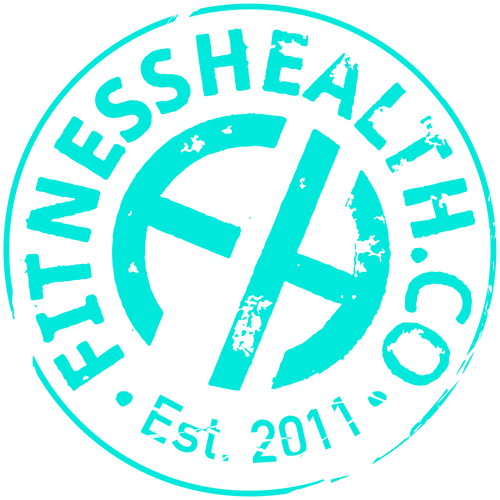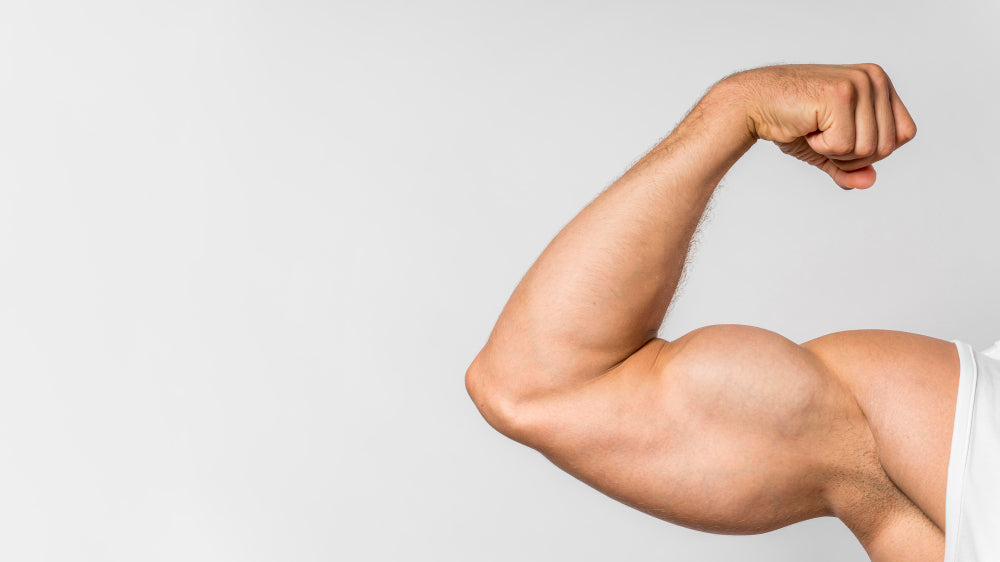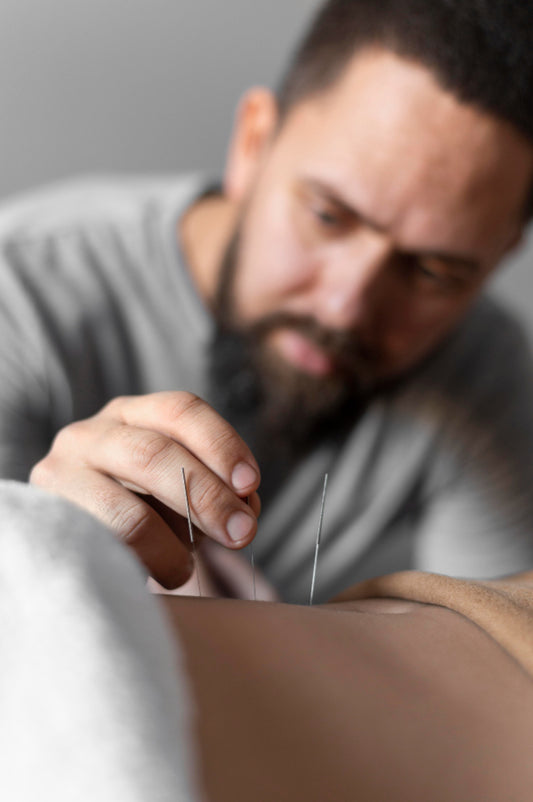Achieving massive biceps is a common goal for many fitness enthusiasts! To realize this ambition, performing targeted exercises correctly is crucial. Numerous exercises are designed specifically to engage the biceps and its various muscle groups.
However, it's vital to comprehend which exercises focus on each muscle and their mechanics. Without this knowledge, attaining your desired outcomes could be more time-consuming than anticipated.
In this guide, our main objective is to unveil some of the top exercises for the long head of the bicep, enabling you to achieve the muscular biceps you've always desired.
Moreover, we'll provide a concise overview of the biceps muscles and their mechanisms of action.
Therefore, to gain a comprehensive understanding of how to effectively target the long head, along with discovering the most efficient exercises for this purpose, make sure to read through to the conclusion!

Understanding The Bicep Muscles
For the most effective biceps training, it's crucial to grasp the functions of the bicep muscles. The biceps brachii, commonly known simply as the biceps, plays a key role in several arm movements. Its primary functions include:
1. Elbow Flexion: The biceps are primarily responsible for bending the elbow, bringing the forearm towards the shoulder.
2. Forearm Supination: The biceps also facilitate the rotation of the forearm, turning the palm upward or forward.
3. Shoulder Flexion: To a lesser extent, the biceps assist in moving the arm forward and upward.
Understanding these functions allows for more targeted exercises that can enhance both the strength and appearance of the biceps by engaging them through their full range of motion and capabilities.
Here’s a brief explanation of all the three muscles essential for the growth of the biceps.
The Biceps Brachii
The biceps brachii is located on the front side of the upper arm and consists of two distinct muscle heads: the long and short heads. Together, these heads form the entirety of the full biceps brachii muscle.
Although the long and short heads merge at the same endpoint, they originate from different locations on the arm. They collaborate to facilitate the flexion of the elbow and movements of the forearm.
Targeting the long head enhances the peak of the biceps, creating a pronounced bulge when the arm is flexed. Conversely, focusing on the short head increases the biceps' width, contributing to a fuller, more robust appearance of the upper arm. There are almost four primary functions of the biceps brachii. They are,
-
Elbow flexion and bending the forearm
-
Movement of the shoulders to raise the upper arm
-
Movement of the upper arms
-
Keeping the shoulder joint stabilized while moving the arms

The Long Head Of The Bicep
The long head of the bicep is positioned on the outer portion of the upper arms and plays a crucial role in endowing the biceps with their strength and distinctive peak.
Focusing on the development of the long head muscle is pivotal for achieving the pronounced biceps appearance admired in professional bodybuilders.
Although distinguishing the long head of the bicep brachii might be challenging at first, its presence becomes apparent when the arm is flexed, visible and palpable along the bicep's length. Its primary contribution is to the overall length and peak of the bicep, enhancing the muscle's aesthetic appeal.
That is why it is crucial to target the long head. Otherwise, you will not see any progress.
The Short Head Of The Bicep
The short head of the bicep is situated on the inner side of the upper arm. It is notably broader than the long head, with both heads converging at their endpoint.
Focusing on the short head is key to achieving a wider appearance of the biceps. By dedicating effort to this area, you'll notice your biceps becoming thicker and broader, particularly when flexed.
Isolating the short head can be challenging, as some exercises tend to engage both heads of the bicep. However, specific movements are designed to primarily target this part. Despite this, our primary focus in this context will be on exercises aimed at the long head of the biceps.
Best Long Head Biceps Exercises
If you've managed to develop a broad appearance for your biceps but struggle to achieve prominent bicep peaks, focusing on the long head muscles should be your next step.
While it's true that all biceps exercises engage the entire muscle to some extent, certain movements are particularly effective at activating either the short head or the long head more intensively. Notably, many of the exercises that specifically target the long head involve dumbbells.
Below, you'll find a selection of the most effective exercises for the long head of the biceps. These exercises are designed to minimize the use of body weight, concentrating instead on isolating and targeting this specific muscle group. Along with each exercise, you'll receive detailed instructions and training tips to maximize their effectiveness.
1.Incline Dumbbell Curls
The incline dumbbell curl is an effective way to focus on the long head bicep muscles. By performing this exercise with your arms extended straight down at your sides, your long heads bicep workouts are stretched continuously throughout the movement.
- Instructions
-
Position the bench at an angle of 45 to 60 degrees.
-
Sit on the bench with your back completely resting.
-
Hold the dumbbells with a neutral grip from each hand, and then position your hands straight downwards.
-
Keep your elbow joint fixed in one place, and then bring the dumbbells up slowly. Your upper arm should be completely perpendicular to the floor.
-
After reaching the peak of the curl, return to the original position gradually.
-
Further, correct your form by watching this video.
2. Close Grip Barbell Curls
The close-grip barbell bicep curl variations stands out as a premier exercise for targeting the long head of the biceps. Additionally, performing bicep curls with a close grip can effectively engage the long heads, due in part to the shoulder rotations involved in this variation.
What makes the close-grip barbell curls particularly beneficial is their ability to yield impressive results when performed with heavy weights and fewer repetitions.
However, it's advisable to begin with lighter weights and a higher number of reps, gradually increasing the weight as your strength and technique improve.
- Instructions
-
Start by standing with your feet shoulder-width apart and back completely straight.
-
Then hold the barbell with a closed hand grip and slowly curl the barbell up. Do not move your elbows at all while doing this.
-
Once you reach the top, slowly lift your elbows a little for extra tension and squeeze the long head bicep muscle.
-
Bring the barbell back to its original piston and repeat this movement.
-
Verify whether you are doing this exercise correctly or not from here.
3. Close Grip Preacher Curl
The preacher bench is an outstanding apparatus for bicep training. If your gym is equipped with one, you should definitely incorporate this exercise into your routine.
Preacher curls are exceptionally effective at activating and maximally stretching the long head muscles of the biceps.
The design of the preacher bench is such that it prevents cheating during the exercise. Its restrictive nature is beneficial as it keeps your elbows stationary, ensuring the movement is focused and precise. This bicep exercise is typically performed using an EZ bar to facilitate effective curls.
- Instructions
- Sit straight on the preacher bench.
- Rest your upper arm on the pad of the preacher bench. This way, your forearms will be free to move while the elbows are fixed in one place.
- Hold the EZ bar with a closed hand grip, and with your arms fully extended, start curling the weights till your arms are completely straight and perpendicular to the floor.
- Squeeze your bicep muscles at this point.
-
Now, gradually return to the starting position after completely stretching your biceps.
-
Repeat this movement to complete the rep.
-
Learn more about this exercise from this informative video.
4. Drag Curl
The Drag Curl is an excellent exercise for isolating the bicep muscles, ensuring the rear delts do not contribute to the movement. The positioning of the bicep curl and elbows, kept fixed throughout, mainly targets the long heads, allowing them to stretch fully, thereby activating and isolating these muscles effectively.
This method is also optimal for achieving a strong contraction in the biceps. It comes highly recommended as a valuable addition to any bicep training regimen.
You can perform this exercise using a variety of equipment, including dumbbells, an EZ bar, or a barbell.
- Instructions
-
Hold the dumbbells with a closed underhand grip.
-
Position your hands such that the dumbbells are in line with your shoulders by keeping them shoulder-width apart.
-
Now gradually move the dumbbell up slowly in a straight range of motion by moving your elbows back. It is essential to keep in mind that the higher you move your elbows, the more effective this exercise will be. Do not forget to keep your shoulders completely back and down throughout the exercise.
-
After reaching the entire peak, hold the position and squeeze the biceps.
-
Gradually return to the starting position and repeat for more reps.
-
Correct your formation and learn some training tips from here.
5. Bayesian Curl
This exercise for the long head of the biceps closely resembles inclined dumbbell curls. By performing dumbbell curls with your elbows positioned behind your upper body, you specifically focus on the long head muscles.
This isolates and effectively works on the long head muscle.
This exercise necessitates the use of a cable machine, which offers continuous and constant tension all throughout the movement, unlike dumbbells where the tension varies due to gravity.
- Instructions
-
Start by positioning the cable to the lowest point on the cable machine.
-
Stand with your back facing the machine.
-
Hold the handle with an underhand grip so that your hand is extended behind you.
-
Do a curl without moving your elbows.
-
Return to the starting position and repeat.
-
Watch this video to check your formation.
6. Dumbbell Hammer Curls
Hammer curls with dumbbells are favored by powerlifters and professional bodybuilders for developing large biceps. Additionally, they are excellent for focusing on the crucial long head muscles of the biceps.
The effectiveness of this exercise in targeting the long heads comes from its use of a narrow, neutral grip.
You can do the hammer curl in two positions: sitting or standing. The sitting one is more restricting and effective.
While in comparison, doing hammer curls in a standing position is a relatively easier option, suitable for beginners.
It is also not compulsory to do the hammer curls for both biceps. You can do it alternatively if that's more comfortable for you.
- Instructions
-
Start by sitting with the correct posture, with your back straight and rested against a wall or a backrest.
-
Now take the dumbbells and hold them so that the arms are entirely parallel to the body.
-
With your palms facing inwards, curl the dumbbells up while keeping the elbows fixed in one place. It is important that your elbows don't move while curling.
-
After you feel that the muscles are tensing up, go back to the original position gradually.
-
Repeat this movement with the other hand as well.
-
Follow this video to learn more about this exercise.

7.Chin Ups
Chin-ups are another effective exercise for specifically targeting the long head muscles of the biceps. While they share similarities with other pull-up variations, certain key differences set them apart.
Performing chin-ups isolates the long head muscles through a wide range of motion. The requirement for a very narrow grip during this exercise also ensures focused work on the long head, making it one of the most efficient exercises for bicep development.
By progressively increasing the weight and the number of repetitions, you can achieve those large, impressive biceps you've been dreaming of!
- Instructions
- Hold the pull-up bar with a narrow grip, such that your hands are only a few inches apart.
- Slowly allow your body to hang from the bar completely.
- Now back your shoulders and squeeze the shoulder blades. This step is crucial for proper tensioning of the muscles.
- Start targeting your long head muscles by pulling yourself up till your chest is close to the bar.
- After this position, squeeze your biceps and return to the original position.
- Repeat this exercise till the desired number of reps.
- From this video, you can check if you are doing the chin-ups right or not.
8. Neutral Grip Pull Ups
Neutral grip pull-ups are highly effective at engaging multiple muscle groups, with a particular emphasis on the long head muscles of the biceps.
The neutral grip position places additional stress on the bicep muscles, optimizing their potential for maximum muscle mass and strength gains.
For this exercise, the only equipment needed is a pull-up bar.
- Instructions
-
Jump and hold the pull-up bar using a neutral grip, which means that your palms should be facing each other.
-
Allow your body to hang from the pull-up bar and slowly perform the pull ups, at least till the bar is at your shoulder level. At this point, squeeze your shoulders and bicep muscles.
-
Return to the starting position and complete the reps.
-
You can watch this video to learn more.
9. Zottman Curls
The Zottman curl stands out as a highly effective exercise for engaging nearly all of the muscles in the biceps, particularly emphasizing the biceps brachii and the long heads.
All you need is a pair of dumbbells to execute this exercise, allowing for flexibility in location and the option to work both arms simultaneously or in an alternating fashion. As you carry out the curls, this movement specifically strengthens and develops your biceps by isolating the entire muscle group.
- Instructions
-
Stand completely straight with your feet hip-width apart.
-
Grab two dumbbells and hold them in your hands with your palms facing each other.
-
Gradually pull the dumbbells upwards and stop when the dumbbells are at shoulder level. Now rotate your palms, such that you are now holding the dumbbells with pronated grips.
-
Slowly return to the starting position and make sure that your palms are facing each other again at this point.
-
Watch this video to correct any formation mistakes.

10. EZ Bar Reverse Curl
EZ bar reverse curls are an exceptionally straightforward exercise for focusing on the long heads of your biceps as well as the biceps brachii. They excel in isolating and targeting these specific muscle areas.
What sets this exercise apart from others is the use of an overhand grip to hold the EZ bar, as opposed to a more supinated grip (palms up) grip. This variation directly increases the force applied to the biceps, pushing them towards their maximum potential.
You can perform this exercise easily at home because it just requires an EZ bar.
- Instructions
-
Start by standing with your feet positioned at least shoulder-width apart. Then, grasp the EZ bar with both hands, ensuring you use an overhand grip.
-
Now, slowly pull the EZ bar upwards until the forearms form an angle of 90 degrees or less with the biceps.
-
Pause at this point and squeeze the biceps. Now return to the starting position and complete the reps.
-
Here’s an instructional video on the EZ bar hammer curls.
11. Resistance Band Hammer Curls
Resistance band hammer curls are specifically designed to target the biceps, enhancing their strength and size through muscle mass gain. These curls are easy to perform and bear a close resemblance to traditional hammer curls.
What makes resistance band hammer curls particularly effective is the additional tension provided to bigger biceps by the resistance band. This extra tension significantly aids in muscle growth, helping your biceps achieve their maximum potential in terms of mass and strength.
- Instructions
-
Grab a resistance band with both of your hands and hold it under your feet such that a U shape is formed.
-
Stand with your feet shoulder-width apart and make sure that the faces of your palms are towards each other.
-
Now, perform the hammer curls by bending your elbows and curling the resistance band towards your shoulder with an inward grip. Before lowering your arms, do not forget to pause and squeeze your biceps.
-
Return to the starting position and repeat.
-
Watch this video to get more information about the formation.
Common Biceps Training Mistakes
Many individuals repeat the same errors during their biceps workouts, and these mistakes, if consistently made, can halt or significantly slow the progress of bicep development.
To sculpt well-defined and peaked biceps, it's crucial to execute all exercises in your biceps regimen correctly.
We'll highlight the three most common mistakes in biceps training to help ensure you avoid these pitfalls!
Heavy Weights
In the gym, the temptation to impress others often leads to lifting the heaviest weights available. Many individuals engaged in biceps training operate under the assumption that heavy weights are the key to developing both the peak and width of their biceps.
However, this approach more frequently results in muscle strains and excessive stress rather than the desired muscle gains.
The truth is, proper form and the correct range of motion are significantly more important than the sheer amount of weight lifted. Opting for more repetitions with lighter weights proves to be far more beneficial for muscle development than doing fewer repetitions with heavy weights.
Therefore, to effectively isolate and enhance muscle growth without risking strain or injury, it's essential to avoid this common mistake.
Less Focus On Tension
To achieve massive arms and substantial biceps, effectively targeting the muscles is key. This entails applying the appropriate level of tension to your muscles during workouts.
A critical aspect of biceps training is the lowering phase of the weights, also known as the eccentric phase. It is during this phase that your muscles experience significant strain.
Gaining an understanding of how exercises impact your muscles will teach you how to apply sufficient tension effectively. This knowledge identifies the specific moments during your workout when focused effort is most beneficial.
Thus, proper application of tension enables you to isolate your muscles effectively, eliminating the need for excessively heavy lifting or overtraining.
This will result in the achievement of your fitness goals in a lesser time.
Repetitive Exercises
One of the most significant mistakes in training is the lack of variation. Continuously performing the same exercises without introducing any changes can lead to a plateau in muscle growth. This happens because the body and muscles become accustomed to the specific strains and tension applied during those exercises.
If you find yourself comfortable with your current exercises, consider varying your grips. This simple adjustment can alter the tension on your muscles, providing a new challenge and stimulating growth in different areas.
It's not necessary to overhaul your entire workout routine frequently. Instead, introducing occasional changes or variations can keep both your body and muscles engaged, preventing stagnation and encouraging continuous progress.
Cheating Your Way Out
In the context of biceps workouts, "cheating" refers to simplifying an exercise at a challenging point by incorporating additional movements. At many points during a biceps workout, the arms can become overly fatigued and strained.
As a result, it's common for individuals to incorporate a swinging motion or a forceful pull to complete the exercise more easily.
However, relying on such motions or momentum where they're not intended can hinder muscle growth and the development of muscle mass.
This mistake can be rectified by ensuring other parts of the body are relaxed, allowing you to focus your total energy and strength on the exercise at hand.
For instance, relaxing your back by standing closer to a wall can help keep your shoulders from becoming fatigued, ensuring that the effort is concentrated on your biceps. This approach allows for a more effective workout and promotes proper muscle engagement and growth.
Common Bicep Injuries
The biceps muscles are among the most frequently utilized muscles in our bodies, playing a crucial role in the movements and rotations of our arms, elbows, and shoulders. Additionally, these muscles are subjected to further strain during intense bicep exercises at the gym.
Given their constant use, there is a significant risk of the biceps becoming injured, torn, or strained.
We have outlined four common bicep injuries below. Should you recognize any of the symptoms associated with these injuries, it's important to seek treatment promptly to prevent further damage and facilitate recovery.
Strained Biceps
Strained biceps typically result from overexerting during exercise or lifting weights that are too heavy, leading to the tearing of muscle fibers. This injury is common among those who suddenly increase the intensity or volume of their workouts without adequate preparation or proper technique.
Symptoms
This injury causes acute pain and swelling in your biceps.
Partially Torn Tendons
Partially torn tendons occur when the proximal tendon experiences minor tears at its attachment points, typically around the shoulders or elbows. This type of injury often results from repetitive stress and tension applied to a muscle that is already strained or fatigued.
Symptoms
You will start to feel pain and swelling in your upper arm.
Completely Torn Tendons
This injury occurs when the biceps muscles are subjected to such extreme strain that their tendons become completely torn, resulting in detachment from their attachment points. This severe level of injury typically requires immediate medical attention due to the complete disruption of the biceps muscle-tendon connection, which significantly impacts arm function and strength.
Symptoms
When this type of injury occurs, a distinct snapping or popping sound is usually heard, immediately followed by acute, sharp pain. This initial pain often results in considerably weakened arm movements, highlighting the severity of the tendon's detachment or tear. It's crucial to seek immediate medical attention to evaluate the full extent of the injury and to decide on the best treatment plan.
Popeye Deformity
Popeye Deformity refers to an abnormal bulging of the muscle, named for its resemblance to the cartoon character Popeye's oversized forearm. This condition occurs when the bicep muscle retracts towards the shoulder or elbow following a complete tear of the tendon, causing the muscle to ball up and create a noticeable bulge. This visual deformity happens because the muscle, acting elastically, snaps back to a shortened position from its original attachment point after being torn.
Symptoms
You will notice an unusual bulge in your bicep.

Final words
In wrapping up, focusing on both the short and long head bicep muscles is essential for achieving the desired bicep peak and the ideal width. Proper exercise techniques are crucial to avoid painful bicep injuries.
When executed correctly, exercises targeting the long head will specifically isolate this muscle, leading to well-defined and larger biceps!
Training the long head muscle not only enhances the strength of your biceps but also makes them less susceptible to injuries and undue strains. It's common to see individuals who train extensively yet fail to achieve the bicep shape they desire, often due to not specifically targeting the short and long head muscles.
Furthermore, maintaining a healthy and nutritious diet is vital to stay energized and strong during your workout sessions.
Always prioritize safety and health on your fitness journey. Wishing you the best of luck!









